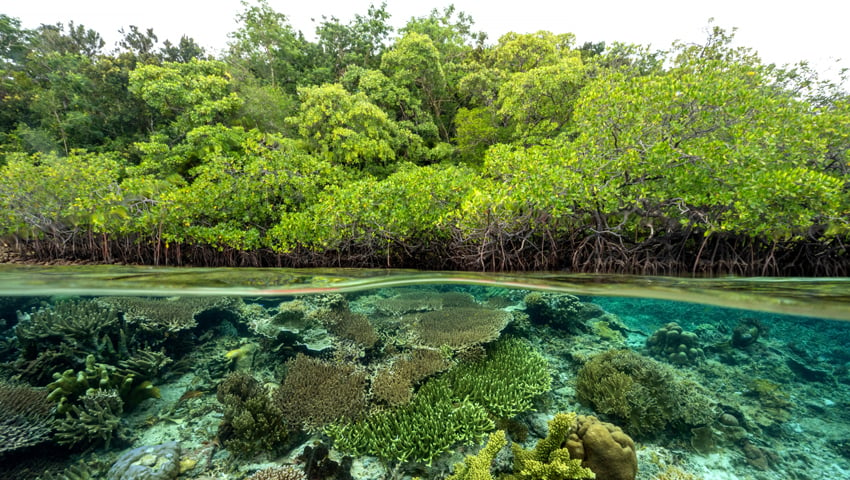This article by Monica Evans first appeared on Forest News and is reproduced under the Creative Commons license.
When the tide is in, the salty understory of a mangrove forest glitters with life. Fish dart through the labyrinthine root systems and find safe spots to mate and spawn; crabs and snails search amongst the fallen leaves; shellfish attach themselves to the trees’ aerial roots.
Mangroves are finally making it onto policymakers’ radars as critical to climate mitigation and coastal protection, but their importance in local diets – particularly by serving as breeding grounds for fish and other aquatic animals – remains under-explored.
Into that gap, a new study by scientists at the Center for International Forestry Research and World Agroforestry (CIFOR-ICRAF), the University of Kent (UK), and Charles Darwin University (Australia) has found that mangroves “contribute substantially to the food security and nutrition of coastal communities in Indonesia.”
When shaping the study, lead author Amy Ickowitz, senior scientist at CIFOR-ICRAF, realised why this particular topic has been explored so little to date.
“It seems that it is very difficult to just see which fish use mangroves and count them up -fish are highly mobile, some use mangroves at different stages of their life cycles, and some fish may not use mangroves directly, but might consume those fish that do,” she said.
“And, even when fish do make use of mangroves, they may be easily substituted by other ecological systems in their absence. Those are just some of the complexities.”
So, instead of wading into these literal and figurative swamps in the hopes of quantifying the fish that use mangroves and that then get consumed by local communities, Ickowitz and co-authors found a way to sidestep these issues, keep their feet dry, and find out what they wanted to know.
“Since our interest is ultimately ‘what does all of this mean for peoples’ diets?’,” she said, “we thought that it would be possible to simply see whether people who live close to mangroves eat more fish than those in neighbouring coastal communities that don’t have mangroves.”
The team tracked down socioeconomic and consumption data – including household consumption of fish and aquatic animals – from a nationally representative survey in Indonesia. Then, using maps of villages and land cover, they identified which villages were coastal, worked out their proximity to mangrove forests and to aquaculture ponds, and analysed the data for correlations.
The results were surprisingly clear. “We expected to find some effect of mangroves on fish consumption, but we didn’t expect it to be so big,” said Ickowitz.
The data showed that people living near mangroves consumed 19–28 per cent more fresh fish than other coastal households, and 13–22 per cent more animal-sourced foods in total. “Since animal source foods are low in Indonesian diets, these effects are very likely to have nutritional significance for households living near mangroves,” said the co-authors.
Meanwhile, the impact of aquaculture on local fish consumption was negligible – and even negative in some cases. This highlights the fact that “aquaculture does not seem to have a very positive impact on animal source food consumption,” said Ickowitz, “further strengthening the message that destroying mangroves for aquaculture is a bad idea not only ecologically, but also for food security.”
Within Indonesia, there has been increasing interest over the last decade in conserving and restoring mangrove forests, but most of these discussions and resulting actions have focused on their outsize contributions to climate mitigation through the large amounts of carbon they sequester and store underground.
“While carbon is an important reason to conserve and restore, foresters, ecologists, and conservationists are often confronted with the argument: ‘what about the potential of feeding the world that agriculture and aquaculture promise through mass clearing of natural landscapes?’” said Mulia Nurhasan, a food and nutrition scientist at CIFOR-ICRAF and a co-author of the study. “This research indicates that mangroves do feed local communities better than when they are converted to aquaculture.”
Recognising these forests’ contributions to the food and nutrition security of those that live near them, and making that visible to all stakeholders, “can give local communities and local governments another important reason to protect them,” concluded the co-authors.
